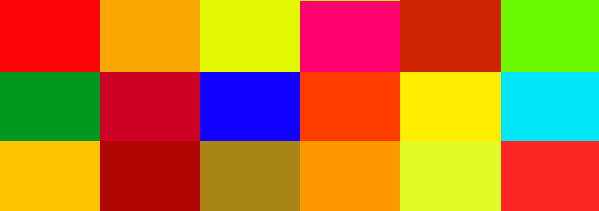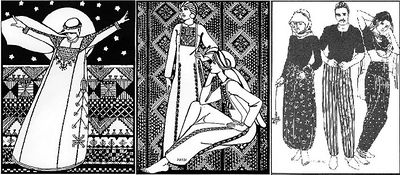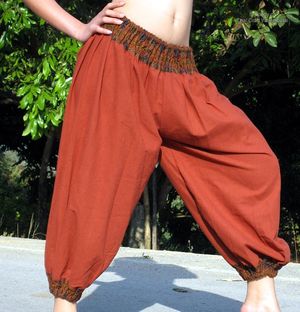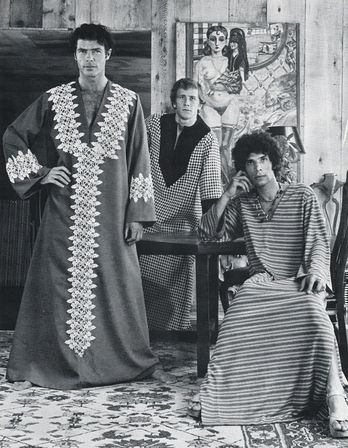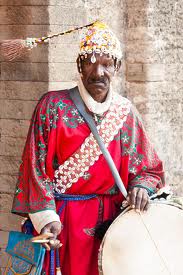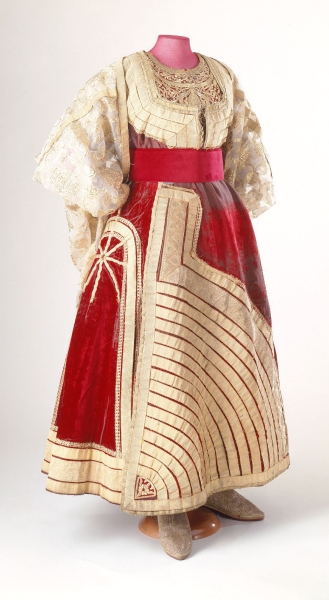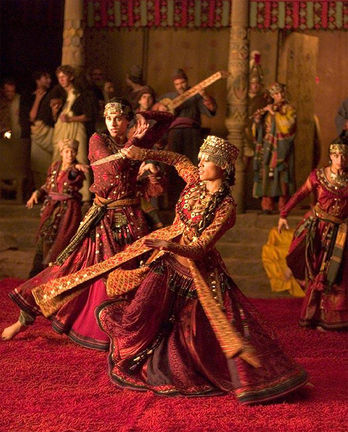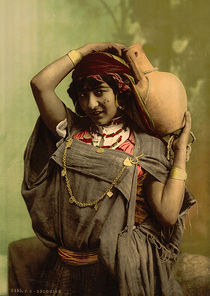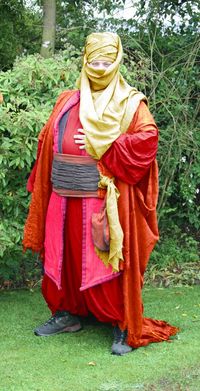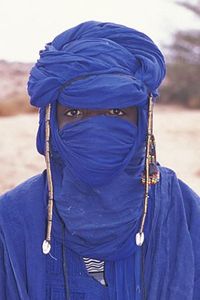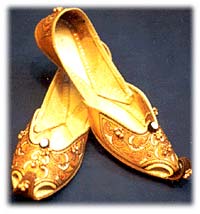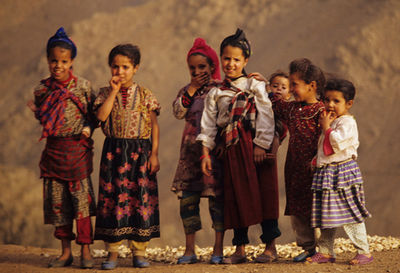The Brass Coast costumes
Note: The tone and style of this page may need editing. All costume advice pages should be written in third person voice, using verbs that make clear that this page is advice, not direction.
Overview
The Brass Coast offers a chance to create some flamboyant and really expressive costumes. The Freeborn attitude to life is all about individuality, passion and luxury, and this is expressed best through their dress. Success is measured in wealth, and what better way to demonstrate that wealth than by wearing it openly? Fine fabrics like silks and brocades are perfect for the Brass Coast, and no Freeborn costume would be complete without plenty of jewellery.
- “Life is short — let it never be dull!”
The Freeborn abhor the mundane and common. Costumes should be as individual as possible and brightly coloured, layered and ever-changing.
Fabrics
The Freeborn look is one of bright colours, silks, jewels and sumptuousness. Midweight silks and brocades work very well for sumptuous base layers. Most costumes should also feature very light top layers, in fabrics like voiles and chiffons, to create movement; the Brass Coast lives for dance and music and the best costumes express this, even when their wearer is at rest.
Layers of light fabrics over heavier ones, in different or even contrasting colours will give a wonderful range of shades which alter as the wearer moves. For example, layered yellow and orange chiffon scarves over a turquoise silk shirt would create some deep green shades in places. Another way of creating changing and colourful outfits is to use ‘shot’ fabrics, also called ‘changeant’. These fabrics change colour as they move and look incredible in flowing robes, scarves and skirts.
Indian and Pakistani clothing and fabric shops, and charity shops near to major Asian areas are great places to look for Sari / Saree fabrics, which are usually lightweight and highly decorated, but often reasonably priced. Sari fabric is often beaded or embroidered, with metallic patterns and sequins being popular. These fabrics can be used to make robes and scarves or worn as they are to make simple wrap around garments. Saris worn the traditional Indian way (wrapped around the waist and draped over the shoulder) are not within the brief for the Freeborn and are better avoided.
Leather is considered unappealing for clothing; it’s a heavy material the Freeborn reserve for boots and armour.
A note on the cold and wet... England being what it is, there will be times when silk and chiffon won't be weather appropriate. If you want to stay warm, layering is the first thing to consider - several layers of linen and silk, in particular, can keep you surprisingly warm. Light wools are also fine, as long as they have some 'flow' to them, and ideally these would be the lower layers with lighter, flowing layers on top.
A woollen robe would be fine as a top layer if you need it, but ideally it'd be decorated with plenty of dangling metallic trim, maybe lined in a bright satin or the like and possibly even embroidered with flames or other Brass Coast images. Fleece linings on lighter fabrics can often work in your favour, and an Anarkali suit or El-keswa (both described below) in a medium weight fabric like jacquard could be lined in wool or fleece and still be perfect.
Head dresses can also work very much in your favour - if cotton or silk wrappings don't keep you warm enough, a woollen skull cap type hat could easily be hidden underneath them.
Colours
With the flame being the central symbol for the Freeborn, it’s no surprise to find them most frequently dressed in strong bright yellows, brilliant oranges and every conceivable shade of red as well as gold and silver. Expensive clothing is made in brightly coloured layers to convey the impression of the fire within.
The Freeborn love all bright, vibrant colours, however, and turquoise, magenta, emerald green and peacock blue will all make an appearance in costumes.
Some creativity with colour will make for the best Brass Coast costumes, using a mixed palate of similar tones alongside one or two strongly contrasting colours for a dramatic effect.
Black is a colour reserved for the dead, and should be avoided in your costumes. Similarly, white is only worn by the very poorest in society and should also be avoided.
Similar nations
Inspiration
The Brass Coast, while primarily a fantasy nation, does draw from Arabic and North African cultures, for example Moorish, Bedouin, Moroccan, Algerian and Tunisian costumes. There are a number of differences between the Freeborn and these real-world cultures, though. Primarily this involves headwear and modesty concerns, and the following are not suitable for the Brass Coast;
- Shemagh, keffiyeh (patterned ‘tea towel’ worn on head) and agal,
- Fez and bandanna.
- All “high” turbans such as the classic Islamic or Sikh turban.
- Everything defined as “sartorial hijab” by wikipedia - burqa, niqab, etc.
Belly-dancing costume is also not encouraged in the Brass Coast, though there are a number of similar options for dance and costume from Egypt and the Middle East which would be perfect. This SCA guide to belly dancing details some of the dances and costumes which would work well for the Freeborn. Also try looking at the Persian dance scene from 'Alexander' for inspiration.
Pinterest Sites
Films and TV
Some of the films you can look to for inspiration are:
- The Last Legion
- Kingdom of Heaven (cosplay details for Sybilla available here)
- Prince of Persia
- Sinbad
- Also, look at the Medjai from The Mummy (cosplay details available here.)
The Clothes
Freeborn society is completely gender blind and their clothing reflects this, with men and women wearing much the same clothes and jewellery. Generally, an outfit will consist of trousers, top, a robe of some sort and a head dress, or a robe and head dress alone. Tunics and robes should be belted with fabric sashes, which can be tied and left long and hanging to the front or side. Clothing is usually worn loose with layers of draped material and will often be ornate and decorated with shiny metal jewellery, bells, coins and other jingly bits. Jewellery should be considered to be part of this costume rather than an accessory. Suitable jewellery can be found very easily through belly dancing suppliers, and coin necklaces, beaded head dresses and hand jewellery are suitable for men and women. Many suppliers also sell the coins, bells and metal discs separately so that you can create your own or decorate your clothes.
Ideally scabbards or pouches should hang at the waist by a silk cord that goes over the shoulder. Any tattoos should be highly intricate, henna-style.
Brass Coast costumes are easy to make as most of the garments are very simple shapes. Folkwear make a range of patterns for North African and Arab style garments which are all perfect for the Brass Coast, for men and women. Patterns 101, 104, 105, 106, 107, 108, 119, 132
If you are looking to purchase your costume, tunic tops can be bought though most LARP suppliers in suitable colours. Traditional Arabic, Indian and North African clothing shops, either online or in Asian areas of most cities are usually inexpensive and easy to find. Most major cities have a few suitable shops selling sari fabric, shalwar kameez and Arabic style robes, although London and Birmingham have the best variety of these sorts of shops. Charity shops in areas with sizable ethnic populations are also a fantastic place to look for these sorts of clothes. Most robes you'll find in Arab clothing stores will be white or pale beige. If you can find these clothes in cotton, however, they will easily accept dyes which can be applied simply using your washing machine! The internet is your friend here, however, and all of the clothes mentioned are available on dozens of websites, plus ebay and etsy. For women's clothing, belly dancing suppliers can be a good place to start your search, but remember to steer away from modern dancing styles like coin bras, loincloths, etc.
Men and women's trousers are loose and flowing, and generally gathered into the ankle. They can be full length, or end just past the knee, open at the sides to reveal part or all of the leg and can be of various designs, resembling harem pants, or Indian shalwar trousers.
- Making harem pants
- Making pantaloons
- Making shalwar trousers
- Video instructions for harem pants
- Pattern for shalwar kemeez
The tunic top is very commonly worn over the trousers, and falls anywhere from the hip to the calf. Again, the Indian shalwar kameez outfit for men and women is a good model to start from. The tunic can be made the same as any other t-tunic, but should be highly decorated around the neck, and slim fitting. Women may wish to make their tunic a 'princess line' style for better fit.
- How to make a T-tunic
- Online pattern for a Kameez
- Simplicity pattern 4528 - currently out of print but available online
Closed robes can be worn instead of, or on top of, a tunic, and should be loose and flowing to the ankle. These could have long flowing sleeves, or be sleeveless to show off the tunic underneath. This garment is based on either the traditional kaftan, or the thobe, but should be brightly coloured and highly decorated as in Moorish Spain and North Africa and not the plain white robe worn in the Middle East. Low necklines, slits to knee or hip and short sleeves could all be used in the closed robe to reveal layers underneath.
A more dress-like version of the tunic is the Anarkali suit, which is a high waisted dress with a full skirt to knee or calf, worn over trousers. A similar garment from Morocco is called the El-keswa. In the film Alexander, the Persian dancers wear a version of this dress, left open below the bust line. and worn with a circle skirt, over trousers.
A Melia is a traditional Tunisian dress/robe, which is simply fabric pinned at the shoulders and either left hanging, or be belted to the body, much like a Roman Stola. This is probably one of the easiest pieces of costume to make, but should be worn over a tunic style top and trousers for Freeborn characters.
Waistcoats and open robes are another possibility to layer over a tunic, or even another robe and a chance to add another colour and more decoration to your outfit. These can be long or short and have long or short sleeves. Several can be worn at once to increase the layered look. Adding scarves to open robes, and one or more fabric sash belts will finish off the Freeborn look.
The preferred Brass Coast headdress is the tagelmust (preferably in bright red, orange or yellow rather than blue) or other veils, scarves, and head-wraps. How to tie a tagelmust video
Veils are worn by both men and women to make them appear more mysterious and alluring, and to frame the eyes or face attractively. Jewellery is very common with the best pieces, like necklaces, crowns or tiaras, also designed to frame the wearers face or the hands.
Shoes in the Brass Coast are often sandals, lacing up over the foot or higher up the leg. Greek, Roman or 'Gladiator' sandals are recommended for this. Arabian or Indian style slippers are also perfect and easy to find for men and women. Leather boots to mid calf or the knee can also be worn, particularly on the battle field.
Children
Children are an opportunity for parents to show off their wealth, dressing their offspring in traditional Freeborn styles. Children in the Brass Coast can be dressed in scaled down versions of their parents clothes. For toddlers and babies simple t-tunics and drawstring trousers are simple and easy to pull-on garments, that can be made in linen or cotton for easy washing! These types of clothes also have plenty of flexibility in terms of size, meaning you'll get more than one year's use out of them. For active children, you may want to consider keeping the costume shorter - robes coming to the knee etc. and simplifying the head dress to a basic scarf.
Top layers that have flexibility in terms of size are the Melia/Stola as described above, and sleeveless robes. With some planning, several years of wear should be possible and so fancy trims and embellishments are ideal for this top layer.
When making costumes for smaller children, remember to avoid anything tight around the neck - strings, cloaks, hats on cords etc and in addition, all tabards should secure under the arms. Make sleeves and armholes wider than needed; they're the bits that get tight as they grow. Neck holes also need to be bigger than for adults or should fasten at the back.
- Information on clothes and swaddling for babies
- Patterns for Medieval children's clothes
- Revival Clothing's Premade items for children
- Gambeson's Premade items for children
Sutannir
A cross between a professional priest and a party organizer, Sutannir conduct important ceremonies such as the coming of age or a wedding, and see to the spiritual needs of the Freeborn as a whole. Before the ceremony many paint their face and limbs with stylised flames in bright colours and dress in flamboyant costumes.
Sutannir characters offer a chance to really go to town on a costume - they dress like other Freeborn, but more so, in everything they wear. Every layer is decorated, every colour is vibrant, they wear layers over layers and top the whole thing off with as many bells and rattling coins as they can find. Sutannir robes should look like living flame, so jagged edges and strips of organza or chiffon should be layered to dramatic effect. The rule with Sutannir costume is 'more is more'. This isn't a look that can be achieved effectively on a very small budget, though for DIY costumers it's a chance to use your skills to good effect.
Corsairs
These daring privateers risk everything ensuring that the Empire's enemies are unable to threaten her shores and earning a fortune in gold in the process. It is a dangerous life but one that perfectly suits the Freeborn passion for high adventure.
Corsair costumes are slightly more restrained than the rest of the Brass Coast, as too many long layers can get in the way when onboard ship or mid battle. They'll mostly be seen in voluminous trousers gathered to the ankle, worn with a large shirt or tunic, and possibly a hip or knee length waistcoat or robe over the top. They will wear their spoils, though, so clothes should still be highly decorated with beads and coins, and they should wear plenty of gold on their wrists and necks.
Armour
Armour, whether metal or leather, should have embellished edges and rich decoration, with calligraphy and ornate designs.
Scale is the ideal armour, ideally in a bright golden colour, worn like mail or else secured with leather.
Chain in the “jannissary” style, particularly the chain helmets, is also great.
Small pieces of plate or breastplates are also good especially if ornate and inlaid.
Leather armour is common, and is usually magnificently tooled and decorated.
Weapons
The perfect Freeborn shield is a domed, round shield that is intricately decorated in gold.
Scimitars are less common than straight swords and axes. The Bhuj, a large heavy single-bladed spear, is the ideal pole-arm. The best quality weapons are intricately etched and engraved.
Bibliography and Resources
- Berber Costumes of Morocco, Marie-Rose Rabate
- The Moors: The Islamic West 7th-15th Centuries AD David Nicolle
Armour
- Totally Leathered provides custom tooled leatherwork & bespoke armour.
- Idiom Productions Costume and Props Workshop creates custom hand-tooled leather armour, clothing and LRP weapons
- Evenlode Studios - High quality leather armour, costume and props handmade
- Darkblade has suitable leather scale for the Brass Coast
Costumes
- Midgard Seamstress Custom made UK LARP and Re-enactment costumes
